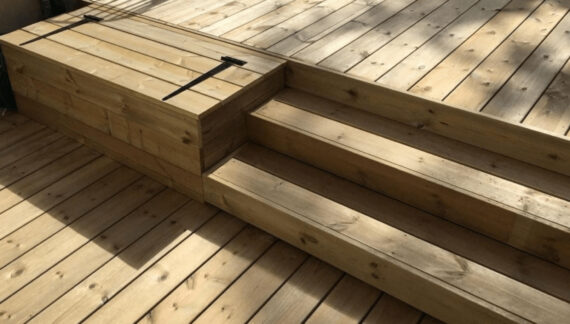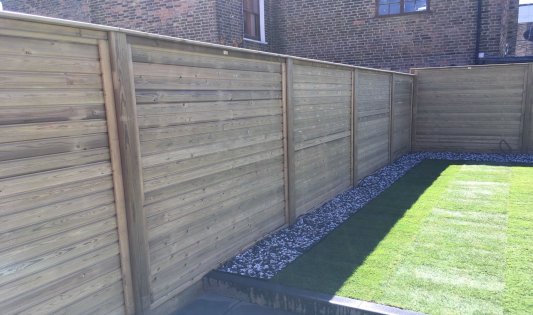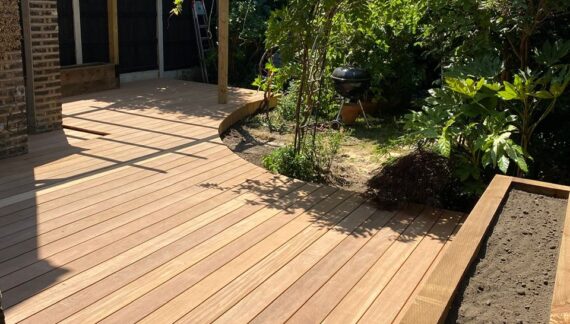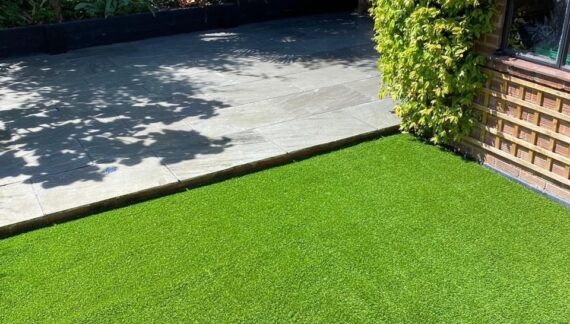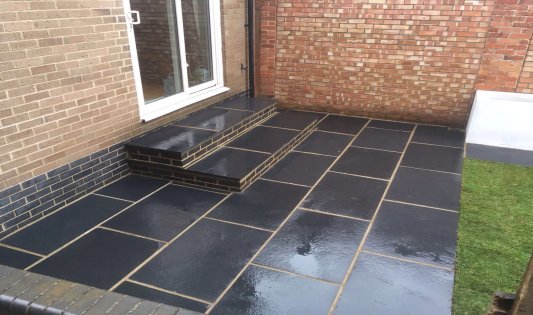Garden decking is a popular choice and looks great in any garden. It provides a very flexible addition to your home as it can be built wherever best suits and creates a great relaxing and entertaining space. As with most things it requires a little maintenance and we share some tips and advice for looking after your garden decking. • Sweep your decking regularly with a hard broom and hose it down to maintain a good deck. • Remove any debris that may have accumulated between the boards using a putty knife. • Use a decking cleaner to remove any moss, algae or dirt from the decking. Aim to do this twice a year. Ideally once in the spring and once in the autumn. Remember to cover your plants before starting to protect them from the cleaning solution. • Do not use any chlorine based bleach for cleaning as although it will clean the deck it will break down the lignin in the deck timber which holds the wood together. • A jet washer can be used to clean the deck but it is really important to not use a heavy duty one. Around 500 to 600 psi but it certainly needs to be smaller than 1500psi. It is really important to test the pressure washer on a hidden area first to make sure it doesn’t damage the decking. Use as wide a nozzle as possible to evenly distribute the water pressure. Hold the pressure washer about two foot above the deck and hold the nozzle at an angle. It should be noted that jetwashing may cause damage to the timber fibres. • Soda crystals can be used to remove any stubborn stains. Water the deck, sprinkle the crystals, and allow to dry before washing away. • Allow the deck to dry for several days before applying any type of finish. • After thoroughly cleaning add a decking oil. Even though your deck has been pressure treated in the manufacturing stage it will need to be maintained. Apply the oil with a brush. Good practice is to oil the decking once or twice a year. • If your wood starts to look tired and grey it needs oiling. • Never drag heavy objects on the surface of a deck to avoid damaging the wood. • Move planters, chairs and tables occasionally to avoid discolouring the decking. • Trim nearby bushes and trees and don’t let leaves and debris pile up in corners.
Winter Garden Checklist
Here is our winter garden checklist for preparing your garden for winter. We tend to not spend as much time in our gardens during the winter. However with the cold weather we do still need to take care of it to keep it in good condition ready for the spring. Here are some tips and advice to protect your garden over the winter. Keep your Patios and Paths Clear These can become slippery in the cold weather with the build up of fallen leaves, moss, frost and maybe a sprinkling of snow. Blow or sweep the area regularly to clear away any fallen leaves and debris and try to keep the area clean. Scatter some salt or grit when frosty to avoid the area becoming slippery. Container Plants You need to protect your containers plants from the cold weather as the frosts can damage the roots. Move them against a sheltering wall and cluster them together for added protection. Add fleece or straw to the containers. To avoid waterlogging from all the rain you may need to lay the posts on their side. Border Plants These are able to fair better than your container plants but they still need a little TLC. Add compost or bark chippings to your beds to feed and insulate the soil. If the snow does come knock it off from your plants as the lack of light and weight can cause severe damage. Trees Your trees and shrubs should be ok over the winter if they are established. For less established or smaller trees or shrubs you can put them in fleece bags for extra protection. Add some bark chippings around the roots. Now is not the time for any pruning or trimming as it could cause damage in the cold weather. Lawns Try to stay off the grass as much as possible during the winter as walking on a frosted lawn could damage the grass. Protect Your Outdoor Water Supply Try to avoid burst pipes on your outdoor taps by making sure that faucets are drained and fully insulated. This also includes any water features you have. Remember to pack away any sprinkler systems you have ready for the summer. Tools Before packing away your tools for the winter give them a good clean. Carry out any maintenance needed at this point so they are ready for use in the spring. Garden Furniture Cover up your garden furniture to avoid any rust or mould. If you can move them into a garage or shed for full protection. Wildlife Now is a really important time to help the wildlife. You can support them by putting out nuts and seeds on bird tables or feeders. You could even make a bug hotel. So that is your winter garden checklist. Time to wrap up warm and get prepared.
Is Winter A Good Time To Re-design Your Garden?
Is winter a good time for a garden makeover? We all want to be able to go out at the beginning of Spring when the sun starts to make a reappearance and enjoy some time relaxing in our garden. We definitely want to be able to relax and enjoy our gardens in the summer! This is why winter is a good time to re-design or get some work carried out in your garden. By getting the work done in the winter you are there fully ready to enjoy your garden when the warmer weather arrives. Plus you won’t be using your garden as much at that time which is another reason why winter is a good time to get landscaping work carried out. You are able to get the work completed with minimal disruption. If you do have the work carried out in spring/summer, there will be a time whilst the project is being carried out that you won’t be able to use your garden quite as much. It will be easier for the landscaping team to work with your garden in winter rather than the summer as the plants and shrubs will be dying back making it easier to move around. The bare bones of your garden are exposed allowing you to see the overall structure and get good sight lines to see what is working in your garden and what isn’t. Plus there isn’t as much wildlife around to disturb which is an important point. This is also a good time if you need to move any trees or shrubs as they will be dormant so you will disturb the roots less. The ground is also softer due to the more frequent rainfall making it easier to excavate if you are having a new patio for example. Another important point to consider is that winter can be a quieter time for landscaping companies. Spring and summer are very busy times when landscaping companies get booked up very quickly, by having your project carried out in the winter you can ensure you can get your project carried out in the timescale desired. You may also find that you may be able to get a better deal on your project. It never hurts to ask to see if there is any wriggle room. Landscaping companies have the machinery and expertise to work in almost any weather so no need to wait until the spring/summer to undertake a project. They are very fortunate enough to be able to see and enjoy all the seasons whilst they carry out their work. Finally, a new garden re-design takes planning, so you can enjoy curling up snugly indoors and looking through magazines or online for inspiration with a nice warm cup of tea. So is winter a good time for a garden re-design? I think it is. Planning a garden makeover of your own? Get in touch via email office@eastlondonlandscapes.com to discuss your project with the experts and get a free quote for the works. Our friendly teams cover East London. We specialise in garden decking, paving and patios, garden fencing, brickwork, lawns, pergolas and raised beds.
Choosing a Fencing Company
Fencing plays a very important role in your garden so it is important to choose the right fencing company to advise and install your fencing. They will be able to share with you their wealth of knowledge and experience. So where to start looking? Recommendations are always a good place to begin. Speak to your friends and family to see if they have someone they would recommend. Then take a look at their website and also look through the company’s social media to see their previous projects and reviews. Work out your budget for the fencing project as costs can vary between the different materials, for example hardwood fencing is more expensive than softwood fencing. Get quotes from different companies to compare. It is a good idea to shortlist three or four companies for quotes. By using a fencing company you are ensuring that you receive an efficient service together with fine craftsmanship. They can also help you with any customisation needed for your fencing and will provide the fencing onsite for you saving you having to source the materials and arrange delivery. In addition they can organise any permits needed for waste removal of your existing fencing. They will advise you on the different fencing options available. Fencing comes in many different materials, styles and designs and they can discuss with you what would work best for your home, understand your preferences and your needs for the project. Is it for privacy, security or decorative purposes? An initial site visit will take place where the various options will be discussed. The next step is a written quote detailing the work involved and the total cost for the project. Then if happy with the quote a start date will be agreed for your project. Feel free to keep in contact with the company if you have any questions on the project. They should be happy to put your mind at ease. If you do have any questions on fencing projects please send an email to office@eastlondonlandscapes.com and we will be happy to help. We cover East London.
Getting Your Patio Clean For Winter
Now is the time to give your patio a good clean to get it ready for the winter. Giving it a clean now also reduces the risk of any mildew growth forming on the slabs. Patios, as with most things, will require some maintenance to keep them looking their best. Remove all of the furniture and plant pots so that you have a clear space ready for work. It will then need a good sweep or a blow over with a blower first to get the area ready for cleaning. There will be leaves and debris to remove that have accumulated over the autumn when the leaves start to drop. Next give your patio a good scrub, either by hand with soapy water and a hard brush, or you can use a pressure washer. A pressure washer is good for removing any stains or spots from your patio but make sure that you have the level set correctly and not too high as this could cause damage to your slabs and potentially blow out your grout causing stability issues to your paving. Hold at a slight angle about 12 inches from the surface and use the fan spray rather than the jet in a diagonal movement across the paving. Test the pressure first on a paver that is out of the way or in a corner. Always wear safety googles when using a pressure washer to protect your eyes from flying debris. Waterproof clothing is also a good idea if you have some to hand as you will get wet! Finally go over the area one more time to rinse away any residue or cleaner from the slabs. Leave to dry for 24 hours. Continue to keep the area clean throughout the winter by sweeping regularly to maintain your paving.
Getting your Patio or Decking Ready For Summer
Now is a good time to take a look at what needs to be done to create that perfect entertaining space for summer. The good news is that there shouldn’t be too many tasks and it shouldn’t take too long. Let’s take a look at where to get started. First thing to do is have a good tidy up of your patio or deck area. Remove all the chairs and pots and give the area a good sweep over to get rid of any debris and leaves. Remove any weeds. Next give it a good clean. You can use either soapy water or give it a light jetwash. Take the covers off your furniture, brush off any bugs or cobwebs and give it a clean. Wipe the cushions down and let them dry out properly. Check the labels to make sure you follow the instructions. Clean any exterior windows or patio doors to make sure that your entertaining space looks very inviting. Clean your bbq ready for the busy summer of grilling ahead. If you have a gas bbq check the bottle to ensure that you don’t run out of gas. Finally think about if you want to add anything to your garden space. Maybe an umbrella or pergola for some sun protection, some lighting for the late summer evenings or adding some more colour to your garden beds with some bright summer flowers. Then sit back, relax and enjoy!
Looking After Your Artificial Grass
Some tips and advice on looking after your artificial grass. People chose to install an artificial lawn as a low maintenance option for their garden. As with anything however it does require a little looking after. Brushing Remove any leaves or debris that have fallen on your lawn. You can use a leaf blower for this task. It is advised to lightly brush your grass once a month to prevent any matting and to keep the fibres upright. You can buy a special artificial rake for this or a use a broom. Spills If you have a spill on your grass dab at the area until it has dried but do not rub the spill. Then add some water to the area. For stubborn stains you can mix washing up liquid and water together to clean the stain with a cloth or sponge. Then rinse off with some water. Weed Killer Weeds can grow up through your artificial grass as artificial grass can be susceptible to airborne seeds. Pull the weeds out when they appear and apply a weed killer twice a year but make sure to use a water-based solution. Hot Objects Avoid putting hot objects directly on your grass as they could cause damage to your grass. Try to avoid placing any items that generate heat on your lawn. Place your bbq on your patio! Avoid placing mirrors or reflective surfaces anywhere that could potentially reflect sunlight onto your lawn as this could cause a burn to the grass. Pet Waste Clean up as soon as you can to avoid pet urine odours. Then clean using hot soapy water if required. You can get artificial grass cleaners to help keep your lawn staying fresh. Never use hard chemicals or strong detergents on your grass. You can also use baking soda then add a diluted solution of vinegar and water to get rid of any odours.
Winter Care Tips For Your Lawn
Here are our winter care tips for your lawn so that it will be looking its best when spring arrives. Avoid Walking On The Grass A big one is to avoid walking on the grass if you can. If the grass is wet and waterlogged walking on it could cause compaction. Your lawn needs a good distribution of air pockets to thrive so you want to avoid compacting the grass which stops the grass from growing. If you get to spring and find that there are puddles on the lawn then use a garden fork to aerate the grass. If there is frost on the grass avoid walking on it as you will break the grass and leave brown patches. Once the spring does arrives if you have been left with patchy or brown areas on your lawn you can rectify this by applying a grass seed or patching in turfs to the damaged area. Get The Leaves Off The Lawn Rake or use a blower to remove any fallen leaves from your lawn as they can block the light to the grass and prevent moisture getting through which can lead to bare patches appearing. Leaves can also encourage disease to the grass. Not only leaves but try to keep the grass area clear if you can over the winter by removing any furniture or toys that are laying around. Remove Any Moss If you see moss on your grass, when the conditions are favourable, gently use a rake to drag it off. Once raked use a fork to make lots of holes into your grass and then brush in some compost or horticultural sand to improve drainage on your lawn. Stop Mowing It is best to avoid mowing in the winter to avoid any damage to your lawn. Only mow if the conditions are favourable and it is necessary and ensure that the cut is around 25% higher than during the summer. With any temperatures below minus 5 degrees your lawn should stop growing and will not need mowing. Fertilise in Spring Wait until the spring to add a treatment to your lawn. Spring and Autumn are the best seasons for treating your grass. These winter care tips for your lawn will help you to take good care of your lawn. Spring will stimulate new growth and your lawn will start to recover from the winter.
Paving Trends For 2023
Patios provide a great space for relaxing and entertaining in your garden. Here we take a look at paving trends for 2023. Always a popular choice, porcelain paving is going to big again in 2023. Porcelain looks great and provides a modern look to a garden. It is a very low maintenance option and a tough paver too, being frost resistant, non-porous and scratch resistant. If you are looking to bring the inside out at your home porcelain is a good choice and if you are keen to try to improve your carbon footprint then consider these pavers as they are made from natural raw ingredients with minimal waste and contain no waterproofing agents, resins or varnish. We will be using a lot of natural stone for our patio projects again this year. Indian Sandstone is very popular as it very versatile and comes in a variety of colours, sizes and finishes to suit all types of garden design. Hand-cut pavers work well in a traditional garden and sawn sandstone suits a more modern look with its clean lines. Sandstone has a long life span as it is a natural stone created over millions or years. When cleaning your sandstone patio avoid using acidic substances and harsh chemicals. Granite is another popular natural stone. Being a natural stone, the composition and colour of the stone will vary and it will have subtle sparkles. It is very hard wearing, heat resistant and there are good slip resistant finish options available. It is another low-maintenance paver. Regarding colour grey paving remains a popular choice as it works well in both modern and older properties. Black is also going to be seen a lot this year, providing a sleek look to your garden. Think porcelain, limestone or granite paving. When planning your new patio area think about your budget, the style and colour you are looking for, the size of the paver and the best location in your garden for the patio. If you are looking to install a new patio and would like a consultation with one of the team to discuss the different products please send an email to office@eastlondonlandscapes.com to arrange a free appointment. We cover East and North London.
Garden Design Trends 2023
At the start of the new year we take a look below at some of the trends for gardens for 2023. The garden has become an even bigger part of the home as we are spending more time at home for work and leisure. Renovations This year many people will be adding to their garden space rather than looking to move home due to higher interest rates. Making their gardens a beautiful oasis to relax and enjoy time with family and friends rather than doing the garden purely for kerb appeal. This can be achieved with a total new garden design or by adding features to your existing space like a new patio or decking area in a beautiful spot in your garden or buying a fire pit or installing a new pergola. If not planning a big makeover, you can add to what you currently have in your garden to create the right mood with new lighting, string lights look great, or by adding new cushions to your existing furniture or painting your fencing to introduce a new colour or look to your garden. The colour of 2023 according to Pantone is Viva Magenta. Wellness Gardens Gardening can be a great stress reliever. Being outside in the fresh air is very relaxing and therapeutic, helping us to feel more positive and hopeful. Make your garden a secret sanctuary by creating a calming space to relax and unwind. Plant beautiful, scented plants to stimulate the senses. Create a shaded area for peaceful contemplation. Add some seating or a water feature as the sound of water is very soothing. Environmentally Healthy Gardens We are moving away from last year’s ‘rewilding’ approach. Wildlife and insects don’t care if our gardens look wild or are more formal. They are looking for shelter, food sources and habitat and they don’t care how our gardens look to find it. This can be found amongst a wilder relaxed garden or achieved in a more structured space. Growing vegetables in urban gardens is on the increase and you don’t need a massive space to do this. Raised beds work very well, however if you are tight on space these can be grown in window boxes. Trailing strawberries hanging down from a window box look good and taste great too! Using Natural Materials With the importance of nature and the environment there has been a rise in the use of natural materials for garden projects. These materials help create a natural look and can prove relatively inexpensive. Adding rocks or pebbles to garden beds or installing a natural stone pathway to meander through your garden. Bringing the Inside Out Using the same or very similar materials to flow seamlessly and bring the inside out. Look at installing the same materials on the floor of your kitchen that follow out to your patio outside. Similar furniture and colours that you use in both your home and garden. Outdoor Living Rooms and Outdoor Kitchens Following on from bringing the inside out, outdoor living rooms and outdoor kitchens are going to be big this year as people plan to spend more time entertaining at home. If not a full outdoor kitchen look at adding a pizza oven or fire pit. Pergolas and Going Vertical To make the most of the space in their garden we are moving vertically in our gardens. Installing pergolas with climbing plants, fence shelving or living walls to add more greenery. With the Summers now getting a little warmer, pergolas provide a bit more shade and extend your living space. You can create a new entertainment space and add definition to your garden. By adding screens or drapes you can increase privacy. Garden Sculptures Adding artwork through a sculpture in the garden is a growing trend for 2023. Adding personality to your garden and providing a focal point. Drawing the eye to an area of your garden that might otherwise be overlooked. Sculptures are also good conversation starters. These are just some of the trends for this year. Design is a very personal choice and you can take ideas from these or have your own.

